Apr 8, 2020
The best and worst outfielders in Blue Jays history
Picking the greatest outfielders in Blue Jays history is much more than a numbers game, Scott Mitchell writes in the second of his nine-part series that looks at the best and worst in the franchise’s history.
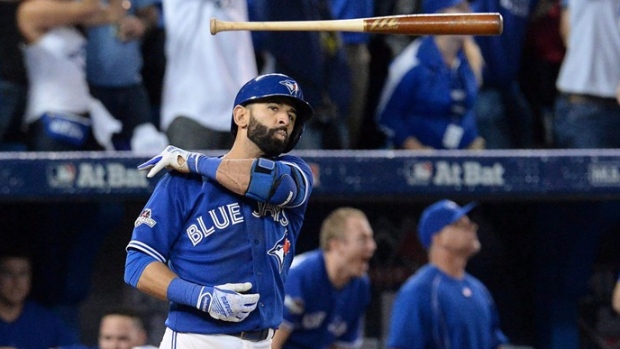
TORONTO — When you reflect back on the greatest players of years’ past, it’s never just a numbers game.
Sure, there are analytically minded people in the sport who would attempt to make their way down a list of Wins Above Replacement leaders and persuade some to follow.
But that’s not how it works for fans who live and die with their teams for years on end, and how moments of greatness can equal sustained greatness in many ways.
Through four-plus decades of Toronto Blue Jays baseball, six outfielders have accumulated 20-plus fWAR.
They’re all names you’d expect to find.
Joe Carter is not among them.
Would anybody debate No. 29’s place in Blue Jays lore?
Probably not outside of a sabermetrics convention, and definitely not in Toronto.
Carter is nowhere near the top of the aforementioned advanced metrics list.
In fact, Carter sits way down at No. 13, accumulating just 7.3 fWAR over his seven seasons in Toronto, behind names like Jose Cruz Jr., Shannon Stewart, Kevin Pillar, and Otto Velez.
Re-sort that all-time leaderboard by outfield home runs and Carter is third with 203 as a Blue Jay, not to mention the six bombs he tacked on in the postseason, giving you a much better indication of why he meant so much to the franchise during its heyday.
With four-plus decades of outfielders to sort through, there’s no shortage of quality players who have roamed the grass in a Blue Jays uniform, but there’s a clear top six when you combine their overall impact, numbers, as well as signature moments.
The Best and Worst of the Blue Jays on TSN.ca:
Mon, April 6 – The five best and worst signings
Wed, April 8 – The five best and worst outfielders
Fri, April 10 – The five best and worst games
Mon, April 13 – The five best and worst trades
Wed, April 15 – The five best and worst infielders
Fri, April 17 – The five best and worst seasons
Mon, April 20 – The five best and worst draft picks
Wed, April 22 – The five best and worst pitchers
Fri, April 24 – The five best and worst moments
Best Outfielders
5. (TIE) Devon White (1991-95); Lloyd Moseby (1980-89)
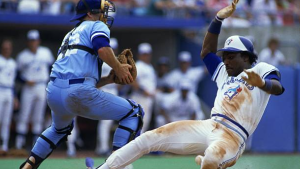 For 15 years, Blue Jays fans were spoiled in centre field.
For 15 years, Blue Jays fans were spoiled in centre field.
Lloyd Moseby, the second-overall pick in 1978, arrived in 1980 and broke out three years later with a five-year peak that saw him threaten the 20/40 plateau each and every season during his prime.
All told, he accumulated 24.6 fWAR across 1,392 games and provided an exciting combination of speed, pop and defence throughout the '80s.
After Moseby’s decline, the baton was quickly passed to Devon White in 1991 after GM Pat Gillick stole him in an off-season trade with the California Angels.
Not only did White take his game to a new level in Toronto right away — his run from 1991 through ’93 were all five-plus fWAR seasons thanks to his elite glove — but he also hit .330 combined in the ’92 and ’93 World Series runs.
Overall, White sits right behind Moseby in total fWAR at 20.9, but he played less than half the games Shaker did.
His catch in the 1992 World Series is a thing of beauty and, yes, it was a triple play.
4. Jesse Barfield (1981-89)
One third of the “Killer B’s” outfield of the '80s, Barfield and the cannon he called an arm were a weapon in right field at Exhibition Stadium from the day he arrived as a regular in 1982.
Known as a hacker, Barfield showed off his all-around game in a 1985 breakout season, hitting 27 homers and stealing 22 bases — the only time he’s swiped double-digit bags — while hitting a career-high .289.
He’d match that batting average the very next season, but he upped his home run total to 40 to lead the league and finish fifth in MVP voting.
Barfield made one all-star game and won two Gold Gloves, while also accumulating 29.6 fWAR, sixth most by any player in Blue Jays history, regardless of position.
If Barfield had one problem besides the strikeouts and some low batting averages, it was that he was overshadowed by the slugger in left field and his Killer B’s brethren, George Bell.
3. Joe Carter (1991-97)
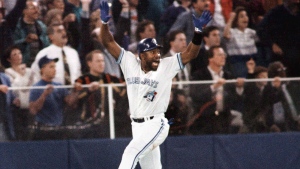 We’ve arrived at Mr. Walk-Off himself.
We’ve arrived at Mr. Walk-Off himself.
Like I laid out, the advanced metrics minimize Carter’s overall importance to the World Series years and it’s the reason that Cooperstown will turn up its nose, but there’s no doubt he was THE run producer in the heart of some very potent and, most importantly, winning lineups.
A five-time all-star with a .781 career OPS in Toronto, Carter’s three-run walk-off shot off Mitch “Wild Thing” Williams in the bottom of the ninth at SkyDome on Oct. 23, 1993 in front of 50,000-plus is the signature moment players dream of.
2. George Bell (1981-90)
There had been a rookie of the year, a manager of the year, and a handful of Gold Glove awards, but the first MVP in Blue Jays history was a special season authored by Bell in 1987.
Bell had already proven to be one of the most feared right-handed bats in the league, finishing in the top 10 in the MVP race the two years prior, but he took his game to another level in ’87, crushing a league-leading 47 homers and running up a .957 OPS.
Striking out way less than most power hitters, Bell accumulated 20.2 fWAR and 202 home runs over nine colourful seasons in Toronto.
1. Jose Bautista (2008-17)
 Sometimes it takes years to properly assess one’s place in franchise history, but we don’t need that much time when it comes to Joey Bats.
Sometimes it takes years to properly assess one’s place in franchise history, but we don’t need that much time when it comes to Joey Bats.
While he still hasn’t officially retired and recently leaked word that he wants to give it a go as a pitcher at the age of 39, it still doesn’t change what Bautista was in his Blue Jays prime, which is to say he was a tightly wound, opinionated star with an astonishing amount of power and bat speed.
His rags-to-riches story provided a narrative, but what Bautista did for baseball in Toronto when he lit up a 54-homer campaign out of nowhere in 2010 is on the same scale as what the Killer B’s did in the '80s and what Carter & Co. did in the '90s, minus the rings.
Bautista helped breathe life back into the Jays after a disastrous decade in the 2000s.
Even more impressive was his 2011 season, one that featured a .302/.447/.608 slash line, 43 homers, and a league-leading 132 walks.
Not only does Bautista rank first among outfielders in just about every statistical category, he also sits fourth in team history with an .878 OPS, well ahead of every player on this list and behind only last names like Delgado, Donaldson and McGriff.
And those signature moments we’ve talked about? You likely don’t need to be reminded what Bautista’s is.
Worst Outfielders
5. Gary Woods (1977-78)
Deciding who are among the five worst outfielders in franchise history is an exercise mostly in subjectiveness.
The true worst of the worst didn’t spent enough days in the major leagues to matter, so while this list is comprised of some ugly numbers, I tried to find players who were at least given ample opportunity to fail and not players who waved at pitches for 17 at-bats.
Woods spent his age-23 and age-24 seasons with the Jays in 1977 and ’78, expertly managing to contribute -1.3 fWAR over 68 games, thanks to a .211/.242/.260 slash line and no home runs.
While he could catch the baseball, Woods was a zero offensively, posting a 31 Weighted Runs Created Plus (wRC+), third worst among outfielders with 100-plus trips to the plate in franchise history.
An original expansion draft pick, Woods was traded to the Houston Astros in 1978 for a minor leaguer named Don Pisker, whose career ended in Triple-A.
4. Ron Shepherd (1984-86)
A pinch-running specialist who somehow managed to steal only three bases his entire career, Shepherd shuttled back and forth between Toronto and Triple-A Syracuse for three seasons in the mid-80s, rarely finding success when he did get the call.
His stat line is pretty amazing.
He appeared in 115 career games, but only walked to the dish 114 times.
In those plate appearances, he struck out in 37 of them, slashing just .167/.204/.278, resulting in the second worst outfielder wRC+ in franchise history at 27.
When 100 is the league average, 27 is ... well, it’s something.
Shepherd posted a -1.5 fWAR in Toronto, so it’s no surprise he was released in March of 1987 and never appeared in the majors again.
3. Mike McCoy (2010-12)
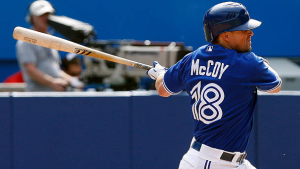 Arriving in Toronto ahead of the 2010 season as a waiver claim from the Colorado Rockies, McCoy hung around and played a role with the Blue Jays for parts of three seasons.
Arriving in Toronto ahead of the 2010 season as a waiver claim from the Colorado Rockies, McCoy hung around and played a role with the Blue Jays for parts of three seasons.
But in 158 games across 374 trips to the plate as a Blue Jay, McCoy finished with a .193 batting average, and the utility-man was remarkably consistent in doing so.
In 2010, he batted .195.
In 2011, it was .198.
In 2012, he managed a .173 mark.
Add it all up and McCoy is the only outfielder in club history with a minimum of 300 plate appearances under the Mendoza Line and it’s not even close, making Billy McKinney (.227), Moises Sierra (.229), Rob Ducey (.231) and Anthony Gose (.234), the next four in line, all look like batting champions.
2. Joe Cannon (1979-80)
I’ve now pointed to wRC+ a couple of times as a way of finding the worst offensive outfielders in Jays history, but this is where it gets really ugly.
Despite an 80-grade name, Joe Cannon, the pride of Camp LeJeune, N.C., holds the distinction of producing close to minus two wins for his ballclub at -1.9 fWAR.
Acquired from the Houston Astros in November of 1978 — catcher Alan Ashby was shipped out of town — Cannon only needed 131 games and 197 trips to the plate to register a -2 wRC+ over the next two seasons with the Jays.
It’s the only negative figure in club history for players with more than 50 trips to the plate, and his .186 career on-base percentage is also the worst in franchise history.
Across four major league seasons and 148 total games, Cannon walked once. Ever.
1. Danny Ainge (1979-81)
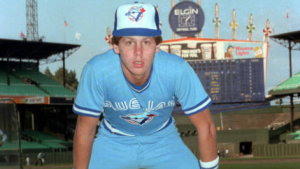 While the other four names on this list played sparingly and the reasons why seem obvious, pre-hoops Danny Ainge was given significant opportunity to make a living playing baseball for three seasons.
While the other four names on this list played sparingly and the reasons why seem obvious, pre-hoops Danny Ainge was given significant opportunity to make a living playing baseball for three seasons.
The results weren’t flattering.
With the understanding that he debuted at the tender age of 20 and was still playing basketball in college as a major leaguer, Ainge never posted an OPS above .578 and his .269 career slugging percentage, second worst in club history for those with at least 500 trips to the plate, makes Munenori Kawasaki look like a power hitter at .301.
Splitting his time between second base (89 starts), third (65 starts), shortstop (5 starts) and the outfield (29 starts), Ainge’s lowly 43 wRC+ is dead last in franchise history.
After being drafted by the Boston Celtics 31st overall in 1981, Ainge made the right decision to hang up his spikes.


